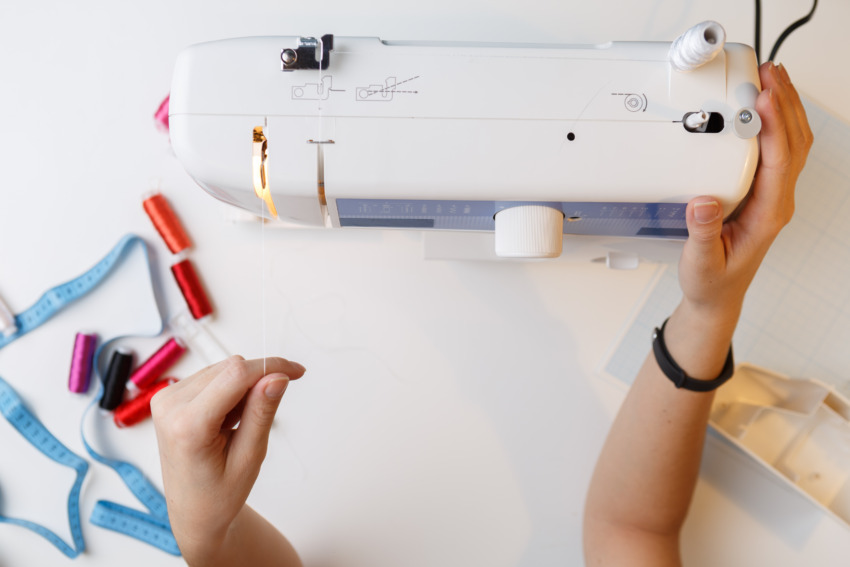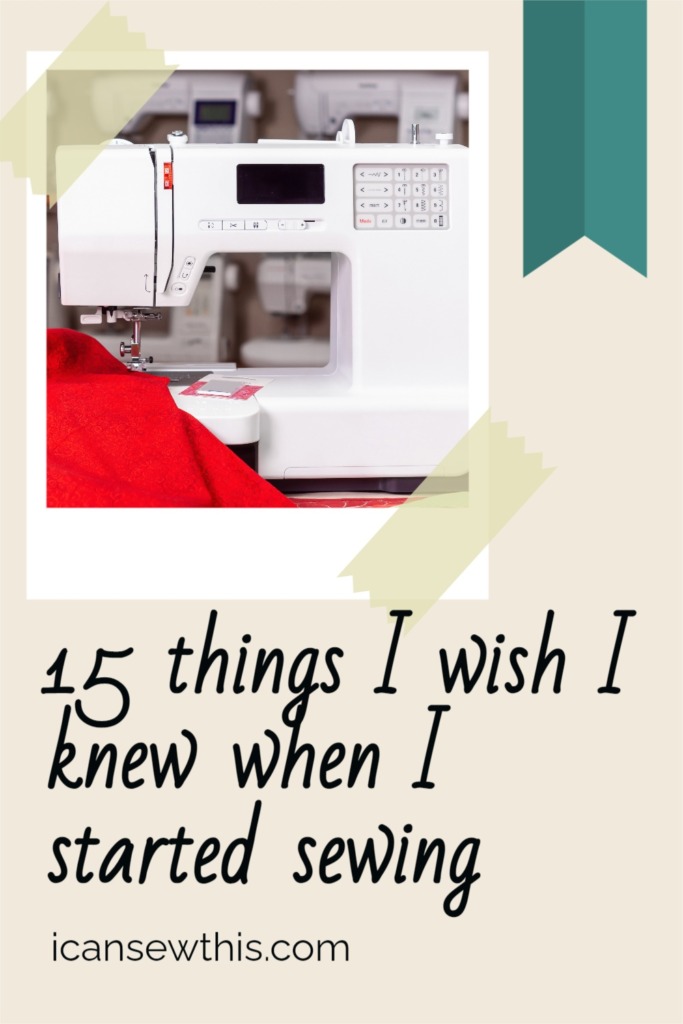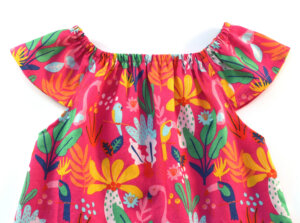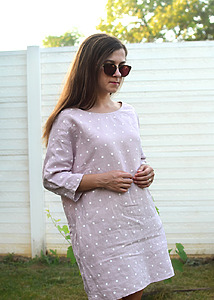Today I want to share some ideas that might help beginner sewists along the way. These are 15 things I wish I knew when I started sewing.
Being a beginner is so cool. You’re basically a blank slate, full of potential, embarking on a new adventure! So much enthusiasm and energy!
On the other hand, I remember all too well going through periods of self-doubt and frustration.
I hope some of these suggestions will make your sewing journey a little smoother.
#1 Anticipate that sewing is going to be hard
Learning any new skill is going to be challenging at times, and sewing does have a steep learning curve. However, it’s totally doable to teach yourself how to sew, and you will be better at it with time.
Never forget that your biggest challenge is your mind. The big secret in life is that there is no secret, to quote a famous saying.
That applies to learning how to sew, as well. There’s nothing hidden. So all you need to know about sewing is already available, on the internet, in books, and in various courses. Trust the process and be patient with yourself.
In my opinion, anyone who works purposefully will be able to achieve their goal.
Here are my best tips for how to sew a straight line.
#2 Don’t compare yourself to others
If you do that, it’s a recipe for unhappiness and discomfort. Strive to compare yourself only to your past self, and take pride in how far you’ve come. Always try to focus your energy on raising yourself up.
If you must compare with an advanced sewist, try to look to the bright side. If you see someone creating something cool, be happy for that person. This is a good opportunity for you to get inspired and motivated. You’ll do something great as well, someday not too far ahead.
#3 Embrace sucking at sewing
You’re a beginner, and you’re totally allowed to suck at sewing! Nobody is expecting perfection out of yourself. My advice is to make the most of this lack of pressure.
There are different stages of the sewing journey, and what you see on social media is always a curated version of reality. There are tens or hundreds of in-progress photos and failures that you’re probably never going to see. Experienced sewists who share their amazing skills and projects struggle too, sometimes.
Making mistakes is the only way to push your skills to the next level.
You know, they say the difference between a beginner and someone good at sewing is the willingness to redo a seam, as many times as it takes. Unpicking a seam does not mean the whole project is a failure.
#4 You don’t need an expensive sewing machine
Most probably, you don’t need a super fancy machine to set you up for success with this hobby. You can easily find a beginner sewing machine for $150 – $300. It doesn’t have to be a big investment, since so many entry-level models will do the job and serve your needs just fine.
If you don’t have a sewing machine yet, here are my suggestions: The best sewing machines for beginners
#5 Show up every day
Practice smart, not hard, as often as you can. It’s better to practice sewing for 10 minutes every day rather than 1 hour every week or so.
To see improvement, choose quality over quantity – it’s preferably to practice frequently, even though it’s for short periods. While sewing, you have to stay focused and your attention has to be on your project and nowhere else.
#6 Be patient and do not take shortcuts
If you’re a beginner, it’s way too soon to take shortcuts. So do press the seams, prewash that fabric, and pin generously every time. You’ll never save time by not ironing! I really wish someone told me that when I was a beginner.
Also, cut as accurately as you can. If you rush through the cutting process, it will always show in your final product.
Once you understand that sewing is not a race, and there’s no reason to hurry, the whole experience becomes much more pleasant and rewarding.
Your entire skillset depends on your patience, so just slow down and take your time. You’ll reap the benefits immediately.
#7 Avoid fabric hoarding
It’s very easy to become a fabric hoarder. When I started sewing, I promised myself I would never become a fabric addict, and I used to find most of the sewing memes appalling. But guess what, seven years later I have a huge stash and a lot of guilt.
The clutter in my sewing room is not good for my mental health, the budget, and neither the environment.
Fabric shopping often feels as fun as sewing itself, but it’s a lot easier to do. There are so many cute fabrics with beautiful patterns in so many different colors, and you feel compelled to buy some, just in case. It’s so easy to have things pile up.
You’ll most likely forget about those fabrics in a week, and then you’ll have trouble deciding what to make with them. I have tens of yards of fabric waiting for the „perfect” project, for years now. A fabric stash is basically junk if all you do is add to it and never use it up.
So if you want to avoid the fabric shopping trap, start ignoring the dozens of fabric sales and coupon codes and stop impulse buying.
The key is to choose your sewing project first, and only then buy the fabric. Period. Anything other than that, you’ll end up with a ridiculous stash lying around. You’ve been warned.
#8 Plan your projects
You want your handmade clothes to fit your lifestyle and personality, you want to make clothes that you’ll actually wear. So you can’t just sew a random pattern with a random fabric from your stash.
Be intentional, decide exactly what type of garment you want to sew, then think about what you will wear it with. Take a look at your existing clothes and accessories – shoes, necklaces, bags.
Does that particular color or print look good on you, is the fabric easy to care for? Does the sewing pattern flatter your figure?
These are important questions. Your dream wardrobe should be made up of beautiful pieces you love wearing. What looks stunning on some people on Instagram won’t necessarily look good on you.
On top of that, get to know your body and learn to make modifications to patterns. Most patterns won’t fit you without some alterations, and that’s ok. Making a muslin first is also a good idea.
#9 Learn to read a sewing pattern
Take your time to find out what all those circles, triangles, and other markings on a pattern mean. When you’re a beginner, it’s essential to read your first sewing patterns in their entirety.
#10 Identify your limiting beliefs about sewing
Some people are afraid of sewing zippers, others fear buttonholes, knits, darts, welt pockets, or hemming a circle skirt. All these are limiting beliefs – assumptions that restrict you in some way.
These are just stories we make up in our head – none of the things mentioned above is really that hard. You can accomplish anything you set your mind to.
Once you learn a few tips, a whole new world of sewing will open up for you!
#11 Know when to pivot: curves & corners
It’s not hard at all to sew smooth curved seams or perfect corners. You have to learn how to pivot the machine needle.
First, you have to think of a curve as a troupe of small straight stitches that follow the seam allowance evenly and align with the edges of the fabric.
The fabric should always stay flat while you’re sewing – you never want to pull it and force it round a curve (or a corner).
Stop with the needle in the fabric, lift the presser foot, then pivot the fabric, so that the next few stitches will maintain the same seam allowance. The goal is to stay on course.
It’s the same thing with corners – when you arrive at the corner, stop with the needle in the fabric, exactly at the corner point, then lift the presser foot. After that, pivot the direction of the stitch as needed, put the foot back down, and continue sewing.
#12 Use different needles for different fabrics
Sewing different fabric types will require using different needles, and you should always do a little research when you start a new project. Needles differ not only in size but in type too. There’s not a single needle out there that is the jack of all trades.
Selecting the right needle for your project is crucial.
#13 Finish your seams
There are many different seam finishes you can choose from – zig-zag stitch, with a serger or pinking shears, and French seam, to name just a few.
Finishing the raw edges will have a dramatic impact on any project’s look, so don’t skip this step. When something is as beautiful inside as it is outside, it’s magic!
This will not only elevate the aspect of the product, but it will also take your sewing skills to a professional level.
#14 Change your needle
What if you always sew the same type of fabric? Well, you should know that needles have a life expectancy too, which usually depends on the utilization and the user.
As a general rule, you need to change your needle after about 6-8 hours of sewing, or whenever it becomes bent or dull.
#15 Rethread your machine
Do you know how restarting a computer fixes so many problems, it’s almost like a magic wand? Well, the equivalent of that for the sewing machine is rethreading. If the needle breaks, the thread keeps breaking, or the machine is skipping stitches, just rethread it top and bottom.
And one more thing… Clean and oil your sewing machine every 6-8 weeks.
The first time I cleaned my machine it was so full of lint and dust, I was shocked. A clean sewing machine will run better and smoother. A build-up of lint inside makes it difficult for your machine’s mechanisms to work as expected.







One thing I do now is make a sample of all the stitches available to me on my machine and keep the sampler near by. I used to do only straight stitches or zig zag, that was it!! I was afraid of any other stitch and now I don’t know why. The machine does it all . Those fancy stitches can really make the finished product look good, especially on kids clothes.
The feet that come with a machine these days actually make so much of the work you have to do a fun experience. The button hole used to be scary, now I pop the button into one end of the foot and the machine does the rest. Zippers, gathering, quilting, adding decorative beading, making my own bindings are all a piece of cake. My mom bought me my first sewing machine when I was 12, I kept and used that machine until I was in my 40’s, so my first machine after that was really a mind boggling experience. All the feet and stitches I could now do seemed like out of this world. Don’t get me started on sergers!! My mom bought herself one and while I learned how to thread it for her, I never used one until years later. I now love the serger. Couldn’t get by without it. I’ve learned a lot through the years, I can’t say one thing really that I wished I had learned long ago other than to have faith in yourself and take everything one step further than you think you can. I stayed with really easy patterns and materials for a long time because I was afraid to experiment. I admit to still not working much with stretchy materials because I don’t get some of “rules”.
I still read beginner tips because I believe there is still a really simple easy beginner tip out there that might help me get better. I do not believe I’m above beginner tips and I still learn something new with each article. Material hoarding was something I got from my mother. The only good from that is that there’s plenty of practice materials for my granddaughters to learn on. I have given them one of my machines and they are learning to sew too.
I guess the only other “tip” would be to practice your hand sewing too. You still need to use a needle and thread every now and again and does my hand sewing SUCK!! I’m awful. I recently had a lot of finish work on a project. Luckily, it was the jacket for part of a costume that was to be used one night only for just a few hours, otherwise I would not have let that jacket go out the door. I had to resew the lining down to a suit coat. The UGLIEST finish I have ever done. I would have ripped it out and redone it but there was a time crunch too. At least I now know I better practice some more because I’m sure it will come up again.
I couldn’t agree with you more, Elena! I can relate to this so much! Thank you for your valuable comment. On sewing with stretchy fabrics, I recently discovered the triple straight stitch, and since then, I’ve been using it everywhere with knits! It’s a game-changer. You have to loosen the tension a little bit, and use a ballpoint needle – once you nail it down, the sky is the limit! Maybe you can give it a try. It’s so sturdy that you won’t need the serger anymore, and the seam will never come undone. Super easy!
What a genuine post- thank you! Lots of great tips
Leana, thank you for your comment! I’m so glad you find this post useful.